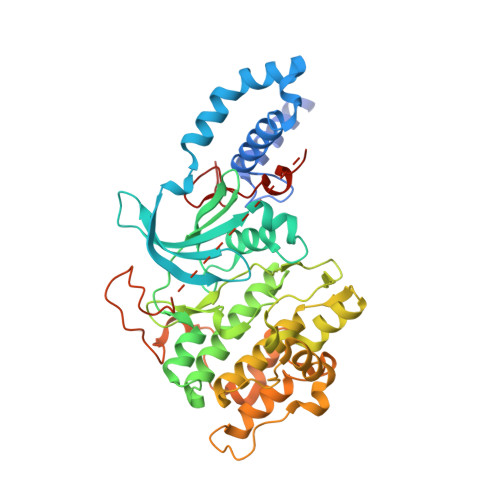Co-crystal structures of inhibitors with MRCK, a key regulator of tumor cell invasion
Heikkila, T., Wheatley, E., Crighton, D., Schroder, E., Boakes, A., Kaye, S.J., Mezna, M., Pang, L., Rushbrooke, M., Turnbull, A., Olson, M.F.(2011) PLoS One 6: e24825-e24825
- PubMed: 21949762
- DOI: https://doi.org/10.1371/journal.pone.0024825
- Primary Citation of Related Structures:
3QFV, 3TKU - PubMed Abstract:
MRCKα and MRCKβ (myotonic dystrophy kinase-related Cdc42-binding kinases) belong to a subfamily of Rho GTPase activated serine/threonine kinases within the AGC-family that regulate the actomyosin cytoskeleton. Reflecting their roles in myosin light chain (MLC) phosphorylation, MRCKα and MRCKβ influence cell shape and motility. We report further evidence for MRCKα and MRCKβ contributions to the invasion of cancer cells in 3-dimensional matrix invasion assays. In particular, our results indicate that the combined inhibition of MRCKα and MRCKβ together with inhibition of ROCK kinases results in significantly greater effects on reducing cancer cell invasion than blocking either MRCK or ROCK kinases alone. To probe the kinase ligand pocket, we screened 159 kinase inhibitors in an in vitro MRCKβ kinase assay and found 11 compounds that inhibited enzyme activity >80% at 3 µM. Further analysis of three hits, Y-27632, Fasudil and TPCA-1, revealed low micromolar IC(50) values for MRCKα and MRCKβ. We also describe the crystal structure of MRCKβ in complex with inhibitors Fasudil and TPCA-1 bound to the active site of the kinase. These high-resolution structures reveal a highly conserved AGC kinase fold in a typical dimeric arrangement. The kinase domain is in an active conformation with a fully-ordered and correctly positioned αC helix and catalytic residues in a conformation competent for catalysis. Together, these results provide further validation for MRCK involvement in regulation of cancer cell invasion and present a valuable starting point for future structure-based drug discovery efforts.
- Cancer Research Technology Discovery Laboratories, Wolfson Institute for Biomedical Research, London, United Kingdom.
Organizational Affiliation:


















